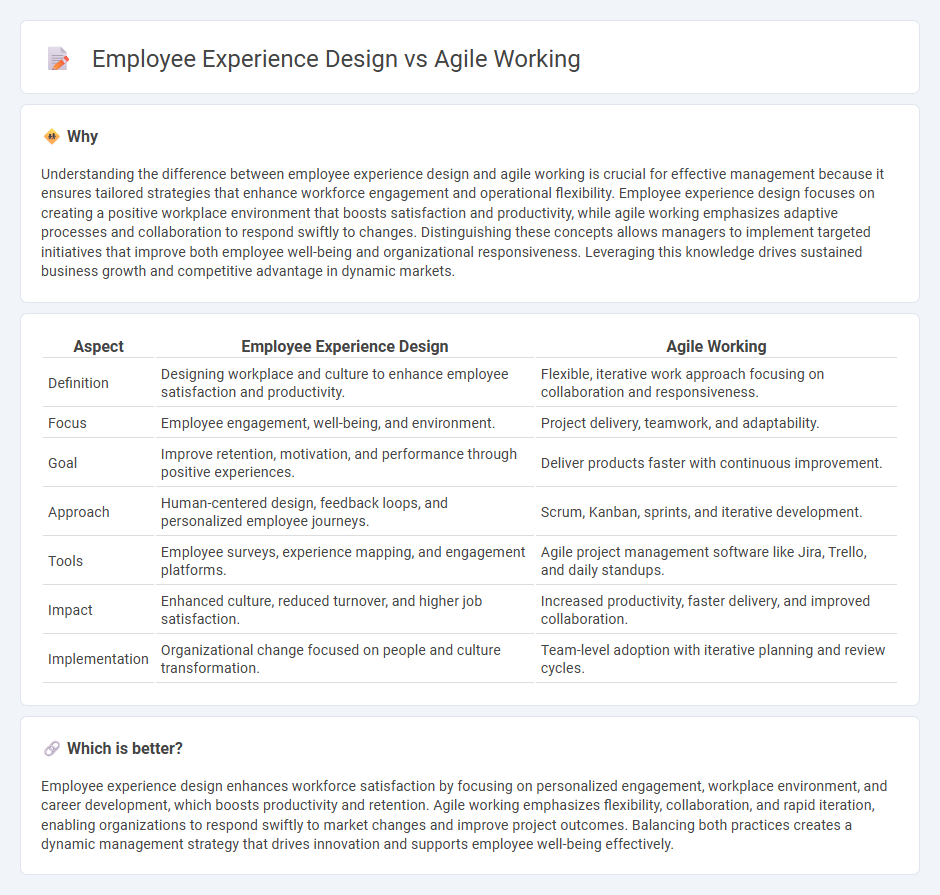
Employee experience design focuses on creating work environments that enhance satisfaction, engagement, and productivity by tailoring processes and spaces to employee needs. Agile working emphasizes flexibility, collaboration, and iterative workflows to quickly adapt to changing business demands and improve team responsiveness. Discover how integrating employee experience design with agile principles can transform your organization's management approach.
Why it is important
Understanding the difference between employee experience design and agile working is crucial for effective management because it ensures tailored strategies that enhance workforce engagement and operational flexibility. Employee experience design focuses on creating a positive workplace environment that boosts satisfaction and productivity, while agile working emphasizes adaptive processes and collaboration to respond swiftly to changes. Distinguishing these concepts allows managers to implement targeted initiatives that improve both employee well-being and organizational responsiveness. Leveraging this knowledge drives sustained business growth and competitive advantage in dynamic markets.
Comparison Table
| Aspect | Employee Experience Design | Agile Working |
|---|---|---|
| Definition | Designing workplace and culture to enhance employee satisfaction and productivity. | Flexible, iterative work approach focusing on collaboration and responsiveness. |
| Focus | Employee engagement, well-being, and environment. | Project delivery, teamwork, and adaptability. |
| Goal | Improve retention, motivation, and performance through positive experiences. | Deliver products faster with continuous improvement. |
| Approach | Human-centered design, feedback loops, and personalized employee journeys. | Scrum, Kanban, sprints, and iterative development. |
| Tools | Employee surveys, experience mapping, and engagement platforms. | Agile project management software like Jira, Trello, and daily standups. |
| Impact | Enhanced culture, reduced turnover, and higher job satisfaction. | Increased productivity, faster delivery, and improved collaboration. |
| Implementation | Organizational change focused on people and culture transformation. | Team-level adoption with iterative planning and review cycles. |
Which is better?
Employee experience design enhances workforce satisfaction by focusing on personalized engagement, workplace environment, and career development, which boosts productivity and retention. Agile working emphasizes flexibility, collaboration, and rapid iteration, enabling organizations to respond swiftly to market changes and improve project outcomes. Balancing both practices creates a dynamic management strategy that drives innovation and supports employee well-being effectively.
Connection
Employee experience design enhances agile working by creating environments that prioritize flexibility, collaboration, and continuous feedback, enabling teams to adapt quickly to change. Incorporating user-centered design principles into employee workflows fosters engagement and productivity, which are key drivers of agile methodologies. Organizations that integrate these approaches achieve higher innovation rates and faster project delivery by aligning employee needs with agile practices.
Key Terms
Flexibility
Agile working enhances flexibility by promoting adaptive workflows and iterative processes that respond quickly to changing business needs. Employee experience design incorporates flexibility by creating personalized work environments and schedules that improve satisfaction and productivity. Explore how integrating both approaches can revolutionize modern workplace dynamics.
Empowerment
Agile working enhances employee empowerment by fostering autonomy, collaboration, and continuous feedback loops, which align with the core principles of employee experience design focused on personalized engagement and development. Employee experience design strategically crafts touchpoints that promote empowerment through tailored resources, recognition, and growth opportunities, creating a motivated and resilient workforce. Explore how integrating agile working methods with employee experience design can drive unparalleled empowerment and organizational success.
User-Centricity
Agile working enhances employee experience design by emphasizing user-centricity through iterative feedback and collaboration, ensuring solutions align closely with employee needs and preferences. This approach fosters increased engagement, productivity, and satisfaction by continuously adapting workflows based on real user input. Explore how integrating agile principles with employee experience design drives a more responsive and effective workplace environment.
Source and External Links
What is agile working? - University of Strathclyde - Agile working means managers and staff adopting more flexible ways of working, allowing employees to choose times and locations within agreed parameters to improve work-life balance and wellbeing while still meeting role objectives.
What is agile methodology? - McKinsey - Agile is a mindset and organizational approach focused on adaptability, continuous improvement, and embracing change, requiring comprehensive and iterative transformation across strategy, structure, people, process, and technology.
What is Agile Working? - Agile Alliance UK - Agile working integrates people, processes, technology, and flexible time and place arrangements to enable employees to work efficiently with empowerment and focus on results rather than traditional constraints like attendance.
 dowidth.com
dowidth.com